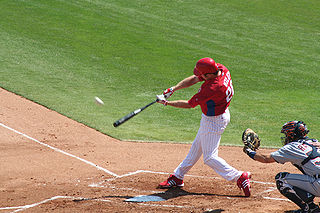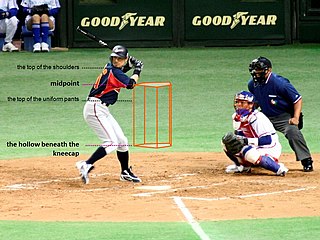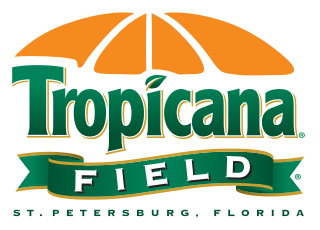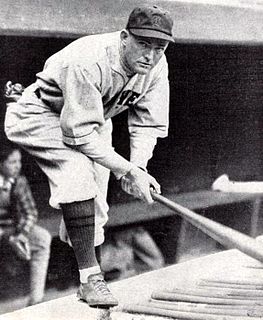 W
WIn baseball, batting is the act of facing the opposing pitcher and trying to produce offense for one's team. A batter or hitter is a person whose turn it is to face the pitcher. The three main goals of batters are to become a baserunner, to drive runners home or to advance runners along the bases for others to drive home, but the techniques and strategies they use to do so vary. Hitting uses a motion that is virtually unique to baseball, one that is rarely used in other sports. Hitting is unique because it involves rotating in the horizontal plane of movement, unlike most sports movements which occur in the vertical plane.
 W
WIn baseball, an at bat (AB) or time at bat is a batter's turn batting against a pitcher. An at bat is different from a plate appearance. A batter is credited with a plate appearance regardless of what happens during their turn at bat, but a batter is credited with an at bat only if that plate appearance does not have one of the results enumerated below. While at bats are used to calculate certain statistics, including batting average and slugging percentage, a player can qualify for the season-ending rankings in these categories only if they accumulate 502 plate appearances during the season.
 W
WA base on balls (BB), also known as a walk, occurs in baseball when a batter receives four pitches that the umpire calls balls, and is in turn awarded first base without the possibility of being called out. The base on balls is defined in Section 2.00 of baseball's Official Rules, and further detail is given in 6.08(a). It is considered a faux pas for a professional player to literally walk to first base; the batter-runner and any advancing runners normally jog on such a play.
 W
WIn baseball, the batting order or batting lineup is the sequence in which the members of the offense take their turns in batting against the pitcher. The batting order is the main component of a team's offensive strategy. In Major League Baseball, the batting order is set by the manager, who before the game begins must present the home plate umpire with two copies of his team's lineup card, a card on which a team's starting batting order is recorded. The home plate umpire keeps one copy of the lineup card of each team, and gives the second copy to the opposing manager. Once the home plate umpire gives the lineup cards to the opposing managers, the batting lineup is final and a manager can only make changes under the Official Baseball Rules governing substitutions. If a team bats out of order, it is a violation of baseball's rules and subject to penalty.
 W
WIn baseball, a cleanup hitter is the fourth hitter in the lineup. The cleanup hitter is traditionally the hitter with the most power on the team and is tasked with "cleaning up the bases," i.e. driving in the runners on the bases.
 W
WIn baseball, a contact hitter is a hitter who does not strike out often. Thus, they are usually able to use their bats to make contact with the ball to put it in play, and then run fast to reach base. As a result of their focus on putting the ball in play, they usually have fewer home runs than power hitters.
 W
WIn baseball, the designated hitter (DH) is a player that bats in place of the pitcher. The position is authorized by Major League Baseball Rule 5.11, and was adopted by the American League in 1973. Since then, almost all amateur, collegiate, and professional leagues have adopted the rule or some variant with the notable exception of MLB's National League and Nippon Professional Baseball's Central League.
 W
WThe Edgar Martínez Outstanding Designated Hitter Award, commonly referred to as the Edgar Martínez Award and originally known as the Outstanding Designated Hitter Award, has been presented annually to the most outstanding designated hitter (DH) in the American League (AL) in Major League Baseball (MLB) since 1973. The award is voted on by club beat reporters, broadcasters and AL public relations departments. All players with a minimum of 100 at bats at DH are eligible. It was given annually by members of the Associated Press who are beat writers, broadcasters, and public relations directors. The Associated Press discontinued the award in 2000, but it was picked up by the Baseball Writers' Association of America, which has administered it since.
 W
WIn baseball, a grand slam is a home run hit with all three bases occupied by baserunners, thereby scoring four runs—the most possible in one play. According to The Dickson Baseball Dictionary, the term originated in the card game of contract bridge, in which a grand slam involves taking all the possible tricks. The word slam, by itself, usually is connected with a loud sound, particularly of a door being closed with excess force; thus, slamming the door on one's opponent(s), in addition to the bat slamming the ball into a home run.
 W
WIn baseball, hitting mechanics studies the biomechanical motion that governs the swing of a baseball player. The goal of biomechanics in hitting during baseball training is to study and improve upon the physics involved in hitting. This includes optimizing a player's swing for either maximizing their "bat speed" or time for plate coverage. There is a wide range of batting stances and mechanics that are developed through individual preferences. However, when comparing among experienced baseball players, their batting mechanics approach are almost similar.
 W
WIn baseball, a lead or lead off is the short distance that a player stands away from their current base. This term should not be confused with "leadoff hitter", which is the first batter of a game or of an inning.
 W
WIn baseball, a leadoff hitter is a batter who bats first in the lineup. It can also refer to any batter who bats first in any inning.
 W
WIn baseball, a pinch hitter is a substitute batter. Batters can be substituted at any time while the ball is dead ; the manager may use any player who has not yet entered the game as a substitute. Unlike basketball, American football or ice hockey, and in a similar way to association football, baseball does not have a "free substitution rule" and thus the replaced player in baseball is not allowed back into that game. The pinch hitter assumes the spot in the batting order of the player whom he replaces.
 W
WThe Silver Slugger Award is awarded annually to the best offensive player at each position in both the American League and the National League, as determined by the coaches and managers of Major League Baseball. These voters consider several offensive categories in selecting the winners, including batting average, slugging percentage, and on-base percentage, in addition to "coaches' and managers' general impressions of a player's overall offensive value". Managers and coaches are not permitted to vote for players on their own team. The Silver Slugger was first awarded in 1980 and is given by Hillerich & Bradsby, the manufacturer of Louisville Slugger bats. The award is a bat-shaped trophy, 3 feet (91 cm) tall, engraved with the names of each of the winners from the league and plated with sterling silver.
 W
WIn baseball, the strike zone is the volume of space through which a pitch must pass in order to be called a strike even if the batter does not swing. The strike zone is defined as the volume of space above home plate and between the batter's knees and the midpoint of their torso. Whether a pitch passes through the zone is decided by an umpire, who is generally positioned behind the catcher.
 W
WIn baseball, a switch hitter is a player who bats both right-handed and left-handed, usually right-handed against left-handed pitchers and left-handed against right-handed pitchers.
 W
WTropicana Field, also commonly known as The Trop, is a domed stadium located in St. Petersburg, Florida, United States, that has been the home of the Tampa Bay Rays of Major League Baseball (MLB) since the team's inaugural season in 1998. The stadium is also used for college football, and from December 2008 to December 2017 was the home of the St. Petersburg Bowl, an annual postseason bowl game. It is currently the only non-retractable domed stadium in Major League Baseball, making it the only year-round indoor venue in MLB. Tropicana Field is the smallest MLB stadium by seating capacity when obstructed-view rows in the uppermost sections are covered with tarps as they are for most Rays games. The stadium currently hosts the professional wrestling promotion WWE, broadcasting its shows from a behind closed doors set called the WWE ThunderDome; this long-term residency began in December 2020 due to the COVID-19 pandemic following a previous residency at Orlando's Amway Center.
 W
WIn baseball, a player earns a Triple Crown when he leads a league in three specific statistical categories in the same season. The term "Triple Crown" generally refers to the batting achievement of leading a league in batting average, home runs, and runs batted in (RBI) over the same season. The term "Pitching Triple Crown" refers to the pitching achievement of leading a league in wins, strikeouts, and earned run average (ERA).
 W
WIn baseball, a walk-off home run is a home run that ends the game. It must be a home run that gives the home team the lead and the win in the bottom of the final inning of the game. Thus the losing team must then "walk off" the field immediately afterward, not finishing the inning, and the winning team can "walk off" the field with the win. The winning runs must still be counted at home plate.